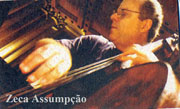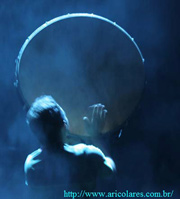|
|
|
www.musicabrasileira.org
Heloísa Fernandes "Candeias"
by: Kees Schoof
September 2009
 |
| CD Candeias |
Some four years ago I ended my review of Heloísa Fernandes' debut album Fruto (2004) with an impatient curiosity about the pianist's next project. It took a while, but the result even surpasses the high expectation that I dared to cherish in my musical wishes.
The pianist/composer from São Paulo (for biographical notes, please visit the review page of Fruto) didn't "just" record a follow-up. Heloísa Fernandes managed to deliver a masterful piece of music that was preceded by some serious research in Brazil's folkloric musical heritage. On the album Fruto it was easy to notice that the pianist combines a very personal style with warm influences from the rich Brazilian music tradition. It must be part of Heloísa Fernandes' talent, since she sublimated her interest in the roots of Brazilian music by a year of intensive studying. The basis of the study was the book "Melodias Registradas por Meios Não-Mecânicos" (Melodies Recorded by non-Mechanical Devices) by anthropologist Mário de Andrade, published in 1946. In that book De Andrade and his erudite research team transcribed during the period 1936-1938 no less than 570 folkloric songs from various parts of Brazil, creating a valuable source of basic Batuque, Cateretê, Caboclinho, Praiá and other folkloric rhythms and styles. The almost forgotten or unconventional conserved music was thus made available for further exploration. And that's exactly what Heloísa Fernandes pursued in her linked up project "Melodias do Brasil: Identidade e Transformação" in which she completely absorbed the anthropologic music and its historical atmosphere. It all served as an inspiration for Heloísa's compositions that we hear on Candeias. The album doesn't serve as a history class but more as a class in how history can form the basis of contemporary music. Music connects to people and people connect to their ancestors. This CD is the reflection of that.
 |
|
Heloísa Fernandes
|
Heloísa chose to work with bassist Zeca Assumpção and percussionist Ari Colares, two musicians who were prominent present on Fruto as well. The three instrumentalists complement each other in a non competitive way, totally dedicated to the essence of the music they perform. The opening "Rebuliço" is a perfect example of this. The percussion can be interpreted as an enlightening illustration of the, at moments, dazzling but always melodic rhythmic forces Heloísa lays down, while the bass offers a restful guideline. Close listening unfolds part of this special magic between the musicians which makes it even more interesting to listen to the rest of the album; a perfect introduction! The majestic theme of "Catirinha" reflects the image of long forgotten dances. In a nostalgic way the pianist musically analyses every part of her composition for us, changing moods in an almost classical way. It's really amazing to hear how grateful music benefits from a perfect control of the instrument. It's the best way to describe the unique quality of Heloísa Fernandes' talent.
 |
|
Zeca Assumpção
|
 |
| Ari Colares |
In "Antoninho," a duet with bassist Zeca Assumpção, the innocent listener will try to escape into a simple waltz motive, but the pianist plays with that rhythmic sentiment immediately and brings it back to its South American basics. The composition turns out to be a lovely exercise in comprehensive listening. While talking about the compositions one can only be deficient in describing its outstanding qualities and do injustice to its historical values. This is music to absorb, to undergo. The best way to listen to this album is to completely surrender and enjoy all the aspects of what this exceptional trio presents to us. The very sentimental conclusion of the album, "Andarilho," is a breathtaking improvisation by the pianist, in which she shows, in the most lyric way, gratitude to the pioneer work of Mário de Andrade and his research team.
The music is perfectly recorded and the accompanying 32-page booklet tells it all in both Portuguese and English, generously illustrated by appropriate excerpts from the inspiring book and by ingenious drawings by Fernando Vilela. How else can this masterpiece be described as a shining crown on an intensive project?
Tracks:
All compositions by Heloísa Fernandes.
Heloísa's music can be visited at her page on MySpace.
Rebuliço
Catirinha
Antoninho
Candeias
Praiás
Andarilho
< voltar
|
|